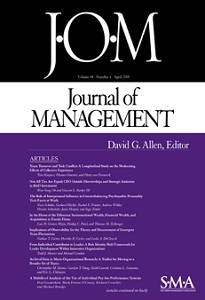Academic articles
Practitioner articles
Working papers
Books
Book chapters
Case studies
Other publications
Subject(s)
Health and environment; Human resources management/organizational behavior; Technology, R&D management
Keyword(s)
Citizen science, crowd science, co-design, sustainability transitions, science and innovation studies, science education
Citizen Science (CS) projects involve members of the general public as active participants in research. While some advocates hope that CS can increase scientific knowledge production (“productivity view”), others emphasize that it may bridge a perceived gap between science and the broader society (“democratization view”). We discuss how an integration of both views can allow Citizen Science to support complex sustainability transitions in areas such as renewable energy, public health, or environmental conservation. We first identify three pathways through which such impacts can occur: (1) Problem identification and agenda setting; (2) Resource mobilization; and (3) Facilitating socio-technical co-evolution. To realize this potential, however, CS needs to address important challenges that emerge especially in the context of sustainability transitions: Increasing the diversity, level, and intensity of participation; addressing the social as well as technical nature of sustainability problems; and reducing tensions between CS and the traditional institution of academic science. Grounded in a review of academic literature and policy reports as well as a broad range of case examples, this article contributes to scholarship on science, innovation, and sustainability transitions. We also offer insights for actors involved in initiating or institutionalizing Citizen Science efforts, including project organizers, funding agencies, and policy makers.
With permission of Elsevier
Volume
49
Journal Pages
103978
Subject(s)
Information technology and systems
Keyword(s)
Information operations, cyber operations, cognitive warfare, disinformation, election interference, principle of non-intervention, sovereignty, self-determination
The article examines the legal qualification of state-led information operations that aim to undermine democratic decision-making processes in other states. After a survey of the legal attitudes of states towards such operations during the Cold War, the impact of the digital transformation on the frequency and quality of information operations is explained. The article then assesses scholarly responses to the outlined paradigm shift regarding the prohibition of intervention, respect for sovereignty and the principle of self-determination. The study then inquires whether it is possible to detect a change in how states qualify adversarial information operations by tracking recent state practice and official statements of opinio juris. The survey concludes that there is insufficient uniformity to allow for an inference that the content of the analysed rules of customary international law has already shifted towards more restrictive treatment of foreign interference. As a possible way forward, the article ends with a proposal to focus on deceptive and manipulative conduct of information operations as the most viable path to outlaw such state behavior in the future. Instead of attempting to regulate the content of information, this approach is better suited to safeguard freedom of speech and other potentially affected civil rights.
© Cambridge University Press and The Faculty of Law, The Hebrew University of Jerusalem 2020
Volume
53
Journal Pages
189–224
ISSN (Online)
2047-9336
ISSN (Print)
0021-2237
Subject(s)
Finance, accounting and corporate governance
Keyword(s)
Loan officer incentives, internal ratings, hard information, Lucas critique
JEL Code(s)
G20, G21
Volume
24
Journal Pages
529–578
Subject(s)
Human resources management/organizational behavior
Keyword(s)
Crowdsourcing, scientific transparency, stimulus sampling, forecasting, conceptual replications, research robustness
Volume
146
Journal Pages
451–479
ISSN (Online)
1939-1455
Subject(s)
Human resources management/organizational behavior
Keyword(s)
Negotiation, first offer, framing, satisfaction, power, reservation price
In distributive negotiations, people often feel that they have to choose between maximizing their economic outcomes (claiming more value) or improving their relational outcomes (having a satisfied opponent). The present research proposes a conversational strategy that can help negotiators achieve both. Specifically, we show that using an offer framing strategy that shifts offer recipients' attention to their reservation price (e.g., “How does my offer compare to your minimum price?”) leads to both (a) an assimilation effect whereby recipients make more favorable counteroffers (economic benefit) as well as (b) a contrast effect whereby recipients feel more satisfied with the negotiation (relational benefit). We find evidence for the effectiveness of this conversational strategy across four experiments (N = 1522) involving different negotiation contexts (real estate, restaurant sale) and participant samples (MBAs, sales agents, online participants), and also document negotiator power as an important boundary condition. Overall, our research suggests that economic and relational benefits do not have to be mutually exclusive in distributive negotiations, that the perceived extremity of an offer is subjective and can be strategically influenced, and that assimilation and contrast effects can operate simultaneously when they relate to separate outcomes.
With permission of Elsevier
Volume
87
Journal Pages
103943
Subject(s)
Information technology and systems
Keyword(s)
Cybersecurity, sovereignty, open source, verification,
supply chain risks
supply chain risks
Increasing dependence on information technology calls for strengthening the requirements on their safety and security. Vulnerabilities that result from flaws in hardware and software are a core problem which market mechanisms have failed to eliminate. A strategy for resolving this issue should consider the following options: (1) private- and public-sector
funding for open and secure production, (2) strengthening the sovereign control over the production of critical IT components within an
economic zone, and (3) improving and enforcing regulation. This paper
analyses the strengths and weaknesses of these options and proposes
a globally distributed, secure supply chain based on open and mathematically proved components. The approach supports the integration
of legacy and new proprietary components.
funding for open and secure production, (2) strengthening the sovereign control over the production of critical IT components within an
economic zone, and (3) improving and enforcing regulation. This paper
analyses the strengths and weaknesses of these options and proposes
a globally distributed, secure supply chain based on open and mathematically proved components. The approach supports the integration
of legacy and new proprietary components.
Volume
29
Journal Pages
30–36
ISSN (Online)
2199-9201
ISSN (Print)
1619-7623
Subject(s)
Economics, politics and business environment; Strategy and general management; Technology, R&D management
Keyword(s)
Market entry, pre-entry experience, demand-side perspective, information & communication technologies
JEL Code(s)
C51, L10, O33
We offer theory and evidence about how the fit between firm experience (supply side) and consumer preferences (demand side) affects postentry performance into a new technology. Specifically, we explore different types of preentry experience (technological and market experience) and use different aspects of postentry performance to draw inferences about consumer heterogeneity. Preentry technological experience (same product and different consumers) helps firms attract a larger share of intensive users (aligning with early adopters) but only if they enter the market early when these adopters make decisions. Preentry market experience (different product and same consumers) helps firms attract a larger share of lighter users, consistent with characterizations of mass market users. Exploiting different components of firm performance in the global second-generation mobile telecommunications industry (average usage intensity and market penetration) allows us to articulate and identify the paths and mechanisms that allow preentry experience to affect postentry performance. The theory as well as important theoretical boundary conditions have implications for research on preentry experience, demand-side heterogeneity, and industry evolution.
© 2019, INFORMS
Volume
31
Journal Pages
245–265
Subject(s)
Finance, accounting and corporate governance
Keyword(s)
Stock price synchronicity, price informativeness, illiquidity, zero returns, corporate transparency, sell-side analysts, control variables, fixed effects, nonlinearity
JEL Code(s)
G12, G14, G15, M40, N20
Volume
37
Journal Pages
419–456
ISSN (Online)
1911-3846
ISSN (Print)
0823-9150
Subject(s)
Finance, accounting and corporate governance
Keyword(s)
Corporate political activism, political connections, Citizens united, stock returns
This paper analyzes the effect that the U.S. Supreme Court's landmark decision on Citizens United vs. FEC had on corporate political activism. The decision opened the door for corporate treasuries to engage in independent political spending. Politically connected firms have lower announcement returns at the ruling than non-connected firms. The estimates suggest that the value of a political connection decreases by $6.9 million. To evaluate the effect of Citizens United on corporate political activism, we explore the fact that Citizens United also lifts bans on independent political spending in states where such bans existed. After the ruling, firms headquartered in states where bans are lifted have fewer state-level connections relative to firms in other states. Overall, our evidence supports the hypothesis that independent political spending crowds out political connections. We do not find any significant crowding-out effects of independent political expenditures on lobbying activity, executive contributions, and political action committees (PAC) contributions.
With permission of Elsevier
Volume
60
Subject(s)
Strategy and general management; Technology, R&D management
Keyword(s)
Learning-by-hiring, inter-firm mobility, innovation, patents
Research has shown that hiring R&D scientists from competitors fosters organizational learning. We examine whether hiring scientists who have many collaborative ties with the hiring firm prior to the mobility event produces different learning outcomes than hiring scientists who have few or no such ties. We theorize that prior ties reduce explorative learning and increase exploitative learning. From our arguments we also derive other testable implications. Namely, we posit that prior ties lead the hiring firm to focus on that part of a new hire’s knowledge with which they are already familiar and that they help appropriate the new hire’s newly generated knowledge. At the same time, prior ties induce new hires to search locally within the hiring firm’s knowledge base and also to produce more incremental, lower-impact innovations. Using data on R&D scientists’ mobility in the Electronics and Electrical Goods industry, we find broad support for our hypotheses. Our results extend our theoretical understanding of learning-by-hiring processes and bear practical managerial implications.
With permission of SAGE Publishing
Volume
46
Journal Pages
287–320


